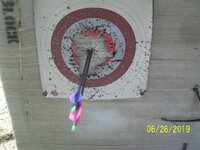Christopher.Reed
Lil-Rokslider
- Joined
- Jul 13, 2022
- Messages
- 148
My draw length is 29". I tend to agree that longer DL likely makes tuning trickier and more sensitive to arrow spine (amongst other factors).
I'm surprised that a .065" change in static spine (assuming that's the only thing you changed) would cause a 6" change in tail behavior. Did you ever get either arrow tuned? If so, did you try the other arrow again afterward? Personally if I got a 300 spine arrow tuned then switched to a 235 spine (at the same length, front/rear weight distribution and same bow specs/settings), I would expect it to tear/fly the same as the 300.
That's a good example of compound bows being able to handle a fairly wide range of spines. You added 10 lbs of draw weight and the same arrow still flew fine.
A longer insert will stiffen dynamic spine to some degree. Whether or not a 2" insert really makes an arrow "behave" a full 2" shorter, I don't know (neither does Archers Advantage or Pinwheel BTW...spine calculators just give approximations based on empirically derived rules of thumb and can't account for every variable in the bow-arrow-shooter "equation").
Dogmatically following the flawed "tail left = too weak, tail right = too stiff" advice can also result in compound shooters wasting time and money. "Check My Spine" threads full of posts laboring over a half inch here and 10 grains there are common on this forum and others when in reality, arrow spine isn't that critical with a compound bow. If I see a horizontal discrepancy in my arrow flight, I check my centershot then adjust cam position/lean then adjust rest windage (if necessary) before I even think about adjusting dynamic arrow spine.
As you mentioned, archery is highly personal and there are many ways to skin the cat. To each his own...if it works, it works. Good discussion.
For confirmation, the arrows referenced above used the same components with the only difference being the GPI and the paper tears which nock tuning had a negligible impact on.
I built several arrows for experimentation with the new bow and the only one that shot bullet holes at center shot was a 710g 200 spine, and the 235 which I upped to 700g had a 1/16”-1/8” tear. These results challenged my assumptions as the lighter 235’s should have produced bullet holes given my understanding.
Regarding quantifying the spine impact of the HIT systems length; I can’t think of a way to test it other than knowing it has an impact of which the degree is certainly debatable. In my circumstance, the HIT was 3.5” or 4” I believe (can’t specifically remember at the moment) and I simply changed the C2C length in AA until it reflected the real world arrow flight I was observing which was 2”. That methodology certainly won’t hold up to any level of rigor but it was noteworthy to me.
I then built an aberration of a 300 spine with 325g up front and a 4.5” HIT calculated at a full 4.5” shorter C2C which was “optimal” according to calculators and was a complete disaster. This proved, to me, that the HIT’s impact was obviously not 100% of its length.
I completely agree with compound bows having a range of acceptable spines, I simply disagree with “no such thing as an arrow too stiff” which is truly dogmatic.
Thanks as always for the input!
Sent from my iPhone using Tapatalk

